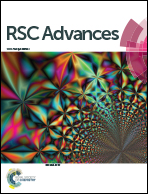Facile synthesis of hair-extract-capped gold and silver nanoparticles and their biological applications†
Abstract
Hair is a waste keratinous biomaterial. In tanneries, hair burning is a common practice, resulting in a residue containing a large amount of COD, BOD, and TDS, which are environmental hazards. Meanwhile, microorganisms have developed resistance against various drugs. Herein, with the aim to utilise this waste hair material, silver (AgHr) and gold (AuHr) nanoparticles were synthesised using NaBH4 as a reducing agent and hair extract as a stabilizing material. The formation and structure of the nanoparticles were scrutinised by different analytical techniques, including UV-Vis, TEM, and AFM. As a result, spherical shaped silver (AgHr) and gold (AuHr) nanoparticles of various sizes, ranging from 4–30 nm, were prepared. The stabilities of AgHr and AuHr toward acidity, alkalinity, salinity, and temperature were also investigated, which showed that they remained stable for more than six months. Moreover, the hair-extract-stabilised silver and gold nanoparticles underwent bioactivity evaluations. The nanoparticles showed promise in multiple applications, including as enzyme inhibitors and bactericidal agents.



 Please wait while we load your content...
Please wait while we load your content...